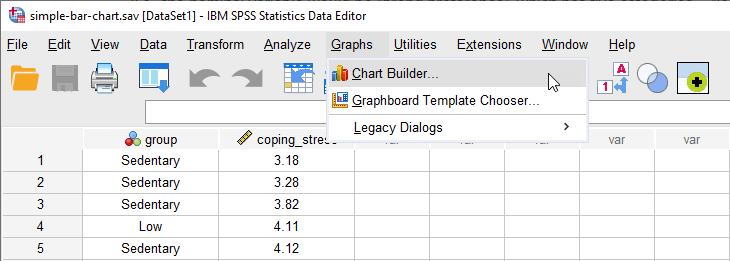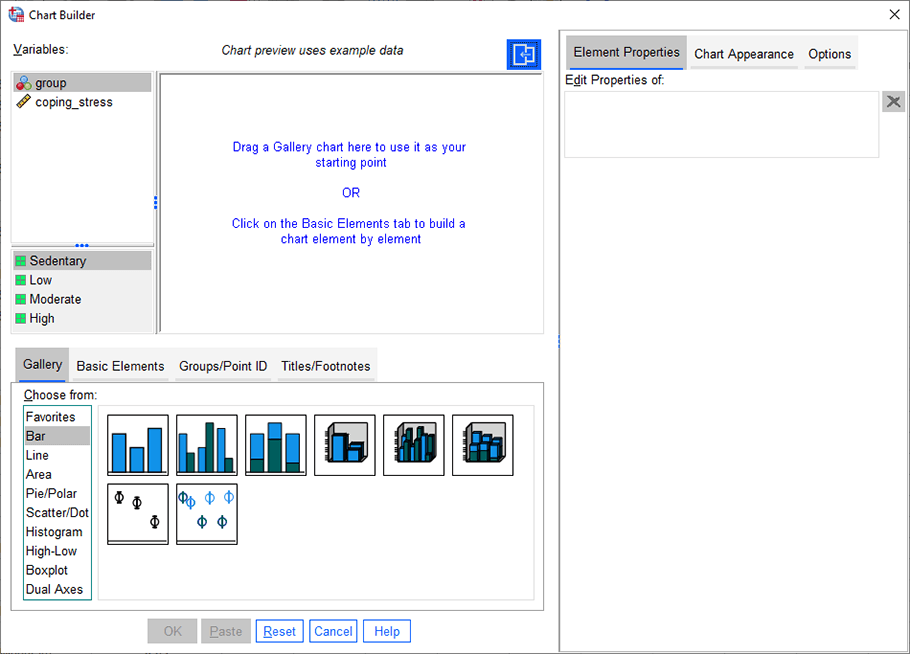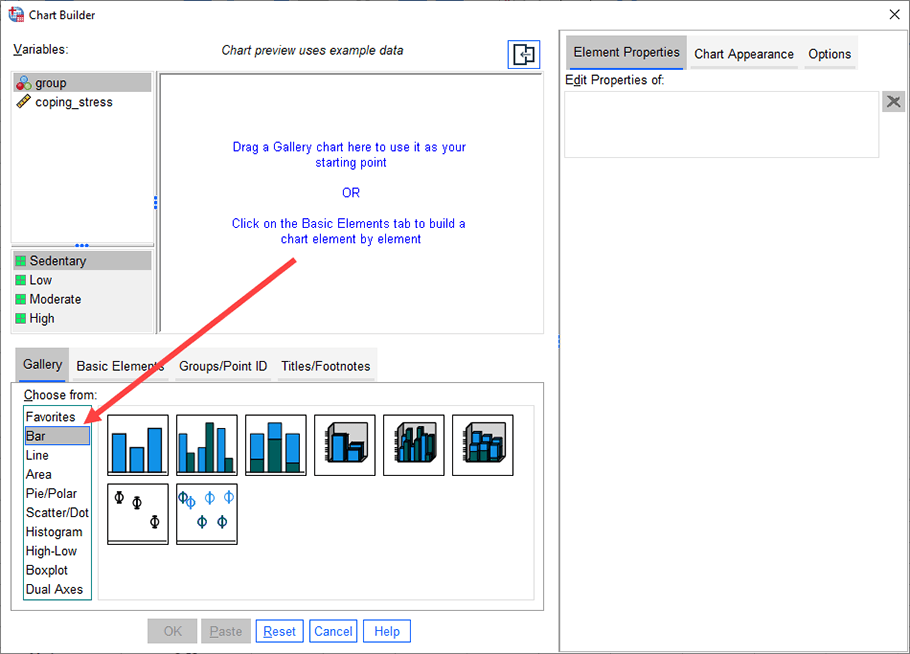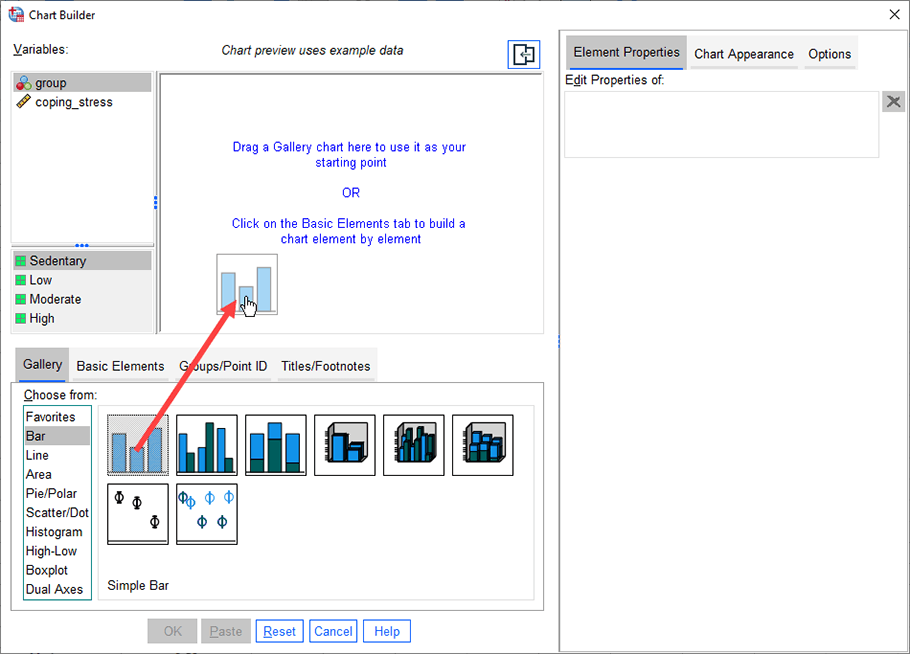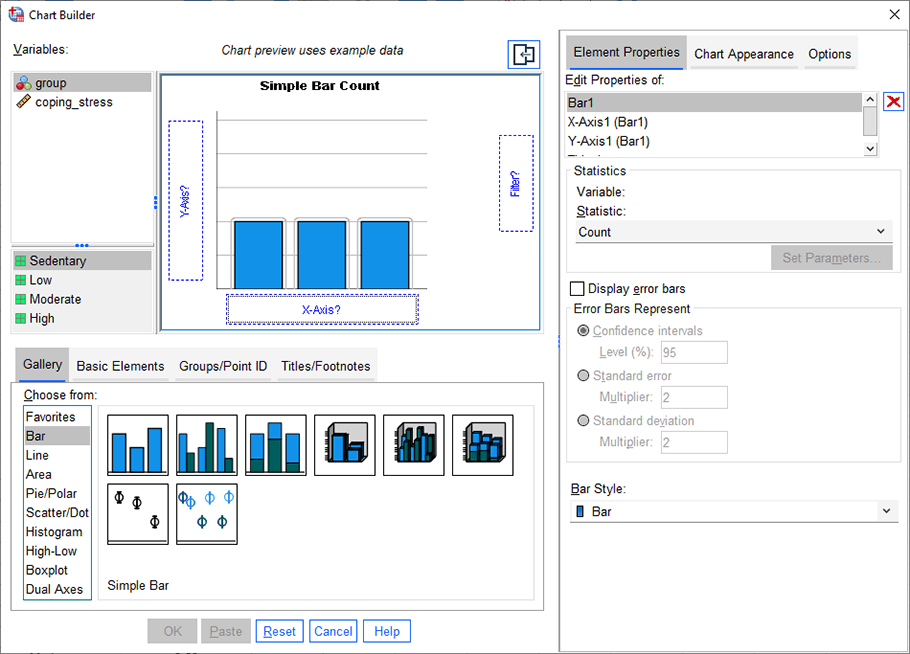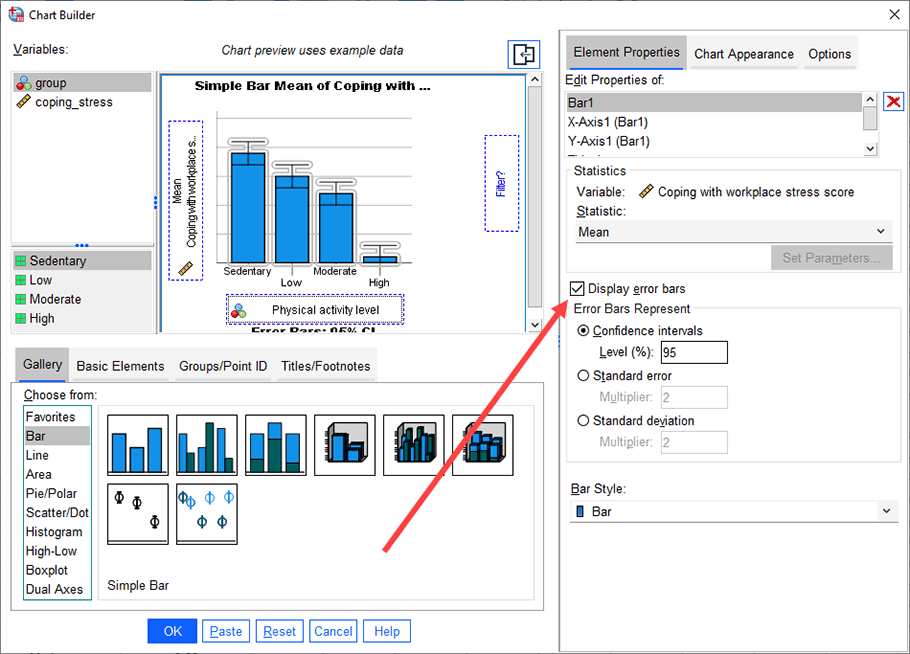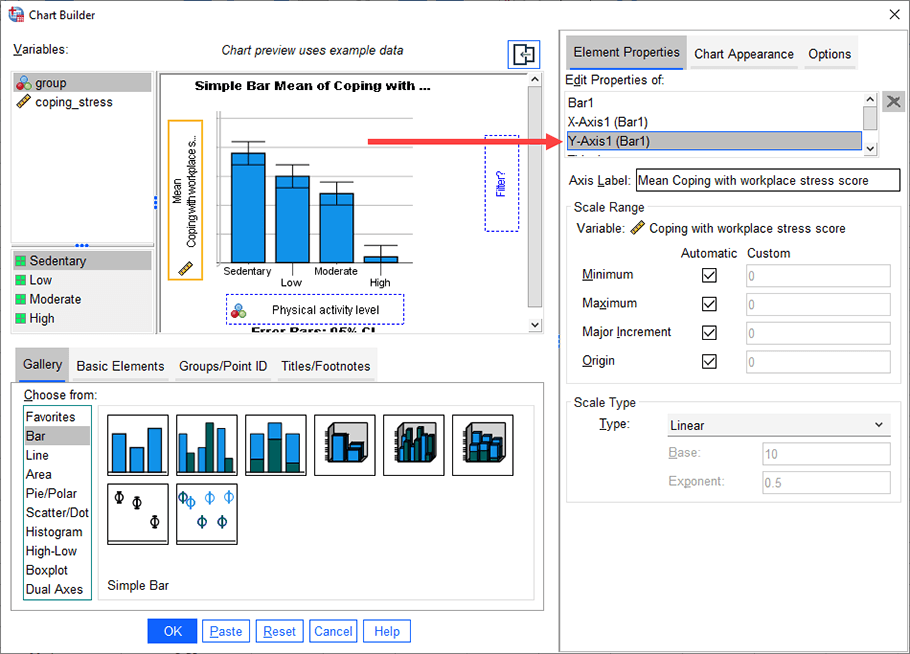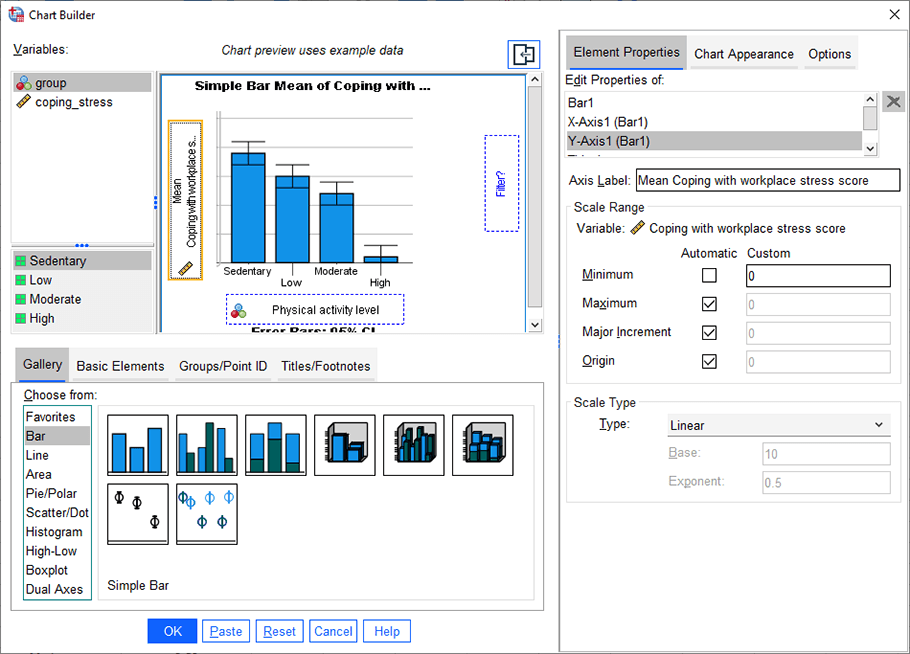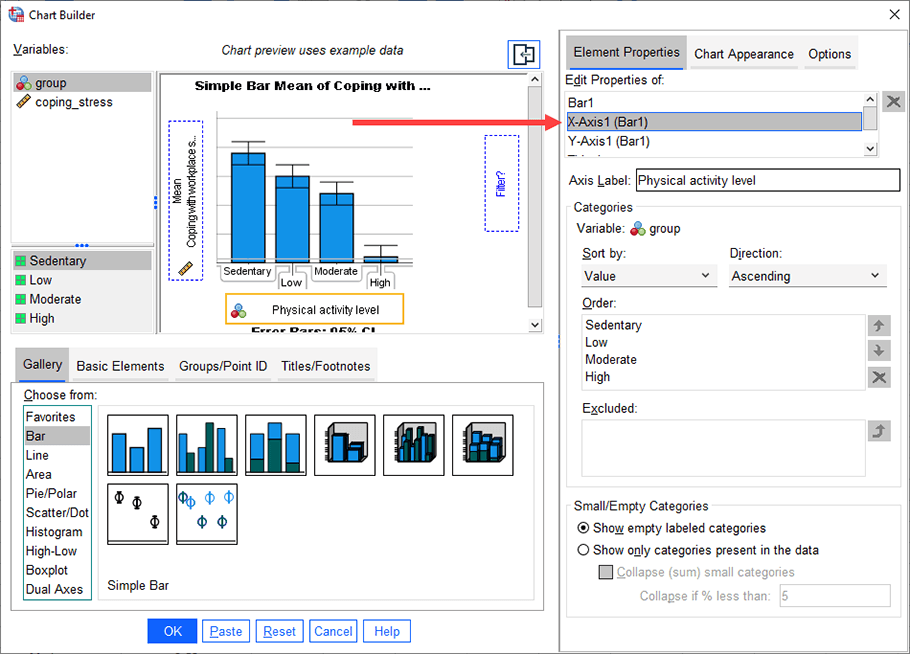Creating a Bar Chart using SPSS Statistics (cont...)
SPSS Statistics
SPSS Statistics procedure for versions 27 and 28
The 10 steps that follow show you how to create a simple bar chart in SPSS Statistics versions 27 and 28 using the example on the previous page.
Note: If you are unsure which version of SPSS Statistics you are using, see our guide: Identifying your version of SPSS Statistics.
- Click Graphs > Chart Builder... on the main menu, as shown below:

Published with written permission from SPSS Statistics, IBM Corporation.
You will be presented with the Chart Builder dialogue box, as shown below:

Published with written permission from SPSS Statistics, IBM Corporation.
- Select "Bar" from the Choose from: box in the bottom-left-hand corner of the Chart Builder dialogue box, as highlighted below:

Published with written permission from SPSS Statistics, IBM Corporation.
- Selecting "Bar" will present eight different bar chart options in the lower-middle section of the Chart Builder dialogue box (as shown above and below). Drag-and-drop the top-left-hand option (you will see it labelled as "Simple Bar" if you hover your mouse over the box) into the main chart preview pane, as shown below:

Published with written permission from SPSS Statistics, IBM Corporation.
- You will be presented with the screen below, which shows a simple bar chart in the main chart preview pane with boxes for the y-axis ("Y-Axis?") and x-axis ("X-Axis?") for you to populate with the appropriate variables:

Published with written permission from SPSS Statistics, IBM Corporation.
Note: You can ignore the "Filter?" box.
- Drag-and-drop the independent variable, group, from the Variables: box into the "X-Axis?" box in the main chart preview screen and do the same for the dependent variable, coping_stress, but into the "Y-Axis?" box. You should end up with a screen like the one below:

Published with written permission from SPSS Statistics, IBM Corporation.
Note: The chart preview pane does not accurately plot the variable data that you have dragged into the preview pane, even though it might appear that it does due to the bar chart's bars changing when you add your variables. Therefore, do not get confused and think that you have done something wrong. You will only see your true data when you actually generate the bar chart.
- Click Display error bars in the
 dialogue box, which will activate the –Error Bars Represent– area. Leave Confidence intervals selected and Level (%): set at 95. You will be presented with the following screen:
dialogue box, which will activate the –Error Bars Represent– area. Leave Confidence intervals selected and Level (%): set at 95. You will be presented with the following screen:

Published with written permission from SPSS Statistics, IBM Corporation.
Note: You can use this area to select other types of error bars, such as multiples of either the standard error or standard deviation.
- Click on "Y-Axis1 (Bar1)" in the
 dialogue box and you will be presented with the following screen:
dialogue box and you will be presented with the following screen:

Published with written permission from SPSS Statistics, IBM Corporation.
Note: You can use this dialogue box to change the axis label (using the Axis Label: box) and/or change scale attributes using the options in the –Scale Range– area.
- If you want to change the scale on the y-axis of the dependent variable, coping_stress, for example, the minimum value, uncheck the Minimum option in the –Scale Range– area so that the Custom value is highlighted and has a value of 0 (zero), as shown below. In this example, everything is OK as it is.

Published with written permission from SPSS Statistics, IBM Corporation.
Note: The procedure above is intended to make the y-axis show a suitable range of values for coping_stress. These values might be different for your variables, so you should adjust them as you see fit. If you are not sure at first what these values should be, don't change the values; see what the simple bar chart looks like and then re-run the simple bar chart with new axes values if necessary. You can also re-edit the simple bar chart later on.
- If you want to change the order of the categories on the x-axis of the independent variable, group, click "X-Axis1 (Bar1)" in the Edit Properties of: box. This will activate the –Categories– and –Small/Empty Categories– areas, as well as the Legend Label: option. Leave the default options selected. However, if you want to change the order of the categories of the independent variable, you can do this in the Order: box in the –Categories– area using the
 and
and  arrows. In this example, everything is OK as it is.
arrows. In this example, everything is OK as it is.

Published with written permission from SPSS Statistics, IBM Corporation.
- Click on the
 button in the Chart Builder dialogue box to generate the simple bar chart, as shown below:
button in the Chart Builder dialogue box to generate the simple bar chart, as shown below:
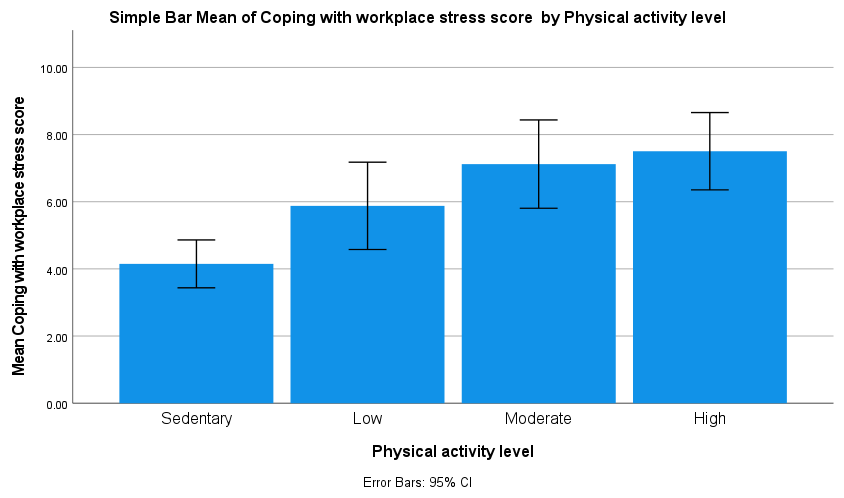
Published with written permission from SPSS Statistics, IBM Corporation.
Note: If the type of simple bar chart that you want to create is different from the example above or there are specific options you want to include in your simple bar chart that we have not covered, please contact us. We will try to add a section to the guide that deals with the type of simple bar chart you want to create.
